Manual Broadcast Setup Model
Reading time ~10 minutes
This article describes how to get you Cinegy software up and running for the Manual Broadcast scenario.
Through the course of this quick guide the following steps will be required to be completed:
Prerequisites
Make sure the machine you are using has the required Microsoft Windows operating system installed along with the latest service packs. Cinegy Air system recommendations are applicable for Cinegy Studio and can be found here.
Make sure that you have at least local administrator rights required to install and configure applications on your computer.
Download the latest Cinegy Air installation package, which contains Cinegy Studio, Cinegy Playout, and Cinegy Prompter, from either the Cinegy Partner portal or the Cinegy Customer portal, or visit the official Cinegy website to download a trial version of the package, which you can evaluate free of charge.
Make sure the Cinegy Air license is applied as per instructions sent along the Cinegy product evaluation e-mail or directly from your sales manager.
Installation
For a manual broadcasting only Cinegy Studio, Cinegy Playout and Cinegy Prompter are required. All these applications should be installed on the same computer.
Cinegy Studio PRO Installation
|
Important
|
This paragraph contains a quick installation guide. For complete description of Cinegy Studio installation, please refer to the Cinegy Studio Manual. |
Follow these steps to install the Cinegy Studio PRO control application:
-
Run the Setup.exe file from the "Cinegy Studio PRO" folder of your Cinegy Air installation package. The setup wizard appears. Press "Next" to proceed with the Cinegy Studio PRO installation.
-
Read and accept the license agreement and proceed with installation.
-
Define the installation folder and press "Next" to proceed.
-
Press the "Install" button to begin the installation. The wizard will inform you that the installation is complete. Press the "Finish" button to exit the setup wizard.
|
After installation, you will find the Cinegy Studio PRO icon on your Windows desktop. |
Cinegy Playout Installation
|
Important
|
This paragraph contains a quick installation guide. For complete description of Cinegy Playout installation, please refer to the Cinegy Playout Manual. |
-
Run the Setup.exe file from the "Cinegy Playout" directory of your Cinegy Air installation package. The setup wizard appears. Press "Next" to proceed with the installation.
-
Read and accept the license agreement and proceed with installation.
-
Define the folder where Cinegy Playout will be installed.
-
Press the "Install" button to begin the installation. The wizard will inform you that the installation is complete. Press the "Finish" button to exit the setup wizard.
-
A message will inform you that computer restart is required. Press "Yes" for the Cinegy Playout installation to be completed.
|
After restart, the Cinegy Playout Dashboard icon will appear in the notification area of the taskbar. |
Cinegy Prompter Installation
|
Important
|
This paragraph contains a quick installation guide. For complete description of Cinegy Prompter installation, please refer to the Cinegy Prompter Manual. |
-
Run the Setup.exe file from the "Cinegy Prompter" directory of your Cinegy Air installation package. The setup wizard appears. Press "Next" to proceed with the installation.
-
Read and accept the license agreement and proceed with installation.
-
Define the folder where Cinegy Prompter will be installed.
-
Press the "Install" button to begin the installation. The wizard will inform you that the installation is complete. Press the "Finish" button to exit the setup wizard.
|
After installation, you will find the Cinegy Prompter icon on your Windows desktop. |
Setup
Cinegy Studio PRO Configuration
|
Important
|
This paragraph contains a quick configuration guide. For complete description of Cinegy Studio configuration, please refer to the Cinegy Studio Manual. |
To start the Cinegy Studio PRO configuration tool, go to Start > Cinegy > Cinegy Studio PRO Config:
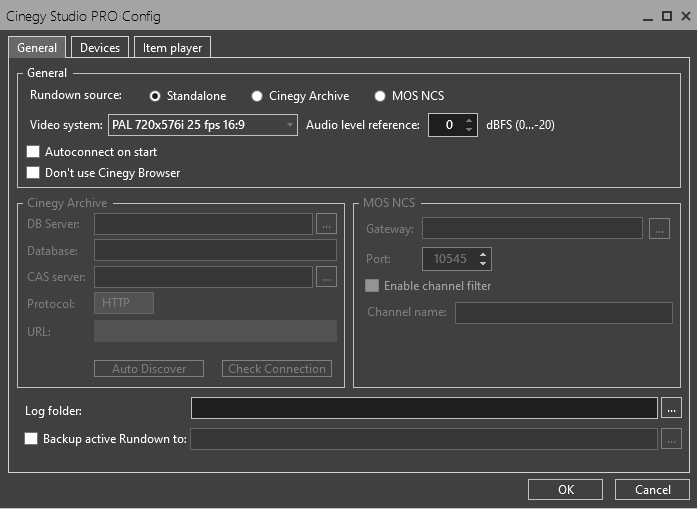
-
In the "General" tab define "Standalone" as a rundown source.
-
From the "Video system" drop-down list choose the TV format to be used for broadcasting and define the aspect ratio for the video stream.
-
Switch to the "Devices" tab to configure the devices. For the demo purposes, enable one video device. For this in the "Video 1" group select "Engine 1", check the "Local" checkbox to use the Cinegy Playout instance configured on your local computer and define the instance number configured in the Cinegy Playout Configurator (in the next step) in the "#" numeric field. In this example scenario it is the instance #0.
-
To be able to send Cinegy Title templates to playout, choose "Engine 1" and "Local" instance #0 in the "Graphics" group. Select layer number 1 for working with one layer of graphics.
-
Configure Prompter: for this enable "Engine" in the "Prompter" group and select "Local" checkbox.
Cinegy Playout Configuration
|
Important
|
This paragraph contains a quick configuration guide. For complete description of Cinegy Playout configuration, please refer to the Cinegy Playout Manual. |
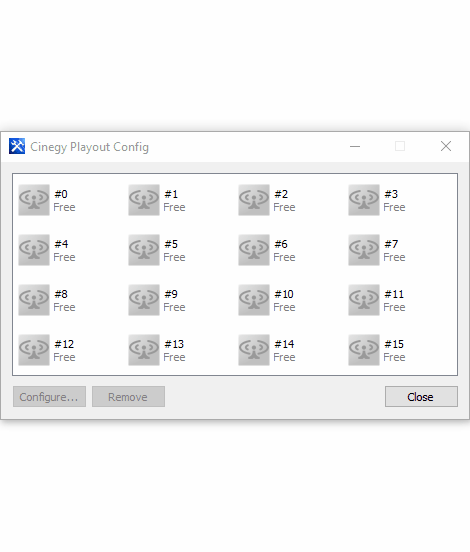
-
To start the Cinegy Playout configuration tool, go to Start > Cinegy > Cinegy Playout Config. It can also be accessed by right-clicking the icon in the taskbar and using the "Open configuration utility" command. By default, no instances are configured and they are all marked as "Free". Select the instance #0 (this instance number was defined during Cinegy Studio configuration) and press the "Configure…" button. The configuration dialog of that particular instance will appear.
-
Optionally, on the "General" tab, specify the instance name.
-
In the "Licensing" tab select the "Cinegy Studio PRO" connection to allow Cinegy Studio PRO client to connect to the corresponding Cinegy Playout engine. The "License usage summary" grid shows the amount and types of required licenses. Make sure all these licenses are available; otherwise, the Cinegy Playout instance will not run at all.
-
In the "Playback" tab in the "Player mode" drop-down list choose the same TV format as defined for the Cinegy Studio playlist in the previous section.
CautionThe video system frame rate should match the frame rate of the content to be used in the playlist. -
To show output on screen for testing purposes, define "Screen Output" as the output device.
NoteFor information about the input and output devices configuration, refer to this article. -
In the "Video effect accelerator" drop-down list choose the video board available on your computer.
-
In the "CG" tab select the corresponding option in the "CG and Channel Branding option" group to be able to send Cinegy Title scenes to playout.
NoteThis step is not required if you are not using Cinegy Title templates. -
Optionally, in the "Logging" tab define the log files creation settings that will simplify the support procedure and help the user in troubleshooting potential issues that may occur.
Launching Cinegy Playout
Cinegy Playout is responsible for the playlist items playback. By default, Cinegy Playout is loaded automatically on system startup and restarts automatically in case of failure.
When Cinegy Playout is started, the corresponding icon is displayed in the notification area of the taskbar. To see and control the status of all instances, right-click the icon in the taskbar and select the "Show Dashboard" command:
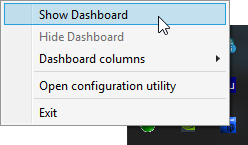
The following Cinegy Playout Dashboard window will appear:

Here you can see the control monitors of all configured Cinegy Playout instances. In this demo guide we have set up one Cinegy Playout instance #0.
|
Press the "Start" button to start the instance broadcasting. |
Each instance can be started/stopped individually.
As "Screen output" was defined as an output device, the window with a blue frame will be open after the Cinegy Playout instance is started. It will display video frames as soon as a media file is sent on air via Cinegy Studio application (this will be described in the next step).
|
Note
|
If you are using trial license, the "Cinegy Demo Version" sign will be imprinted in the center of the frame. |
Cinegy Studio Broadcast Control
When launched for the first time, Cinegy Studio has the default layout.
To connect all configured devices to the Cinegy Playout engine, use the "Connect All" command from the "Playout" main menu.
In this scenario Cinegy Studio was configured to work in standalone mode. This means you need to compose a playlist. Cinegy Studio playlists are called Rundowns. To create a new Rundown, press the "Open" button on the Rundown panel main toolbar. In the window that appears select the desired location and enter the playlist name. The blank Rundown with one Story will be created.
A Story is the basic element of a News Program. It contains scripts, video and graphics covering a separate news story. A Story can be created in Cinegy Studio via the "Create" command in the "Story" main menu. Then media items can be inserted via the "Insert" command from the "Item" main menu.
|
Important
|
Stories can also be created in Cinegy Desktop using the Story Editor which provides versatile functionality for creating, editing and managing news stories. In this case Cinegy Studio should be configured to work in Cinegy Archive mode. Refer to the Working With Stories section of the Cinegy Desktop Manual to learn how to create and fill in Story objects. |
|
Note
|
To be able to see all rundown events for those devices which are inactive and not configured, use the "Preferences…" command from the "Edit" main menu to open the "Preferences" dialog and select the "Display all events" option. |
In this demo scenario Inventory Browser plug-in will be used to fill in the Story in Cinegy Studio. Select and drag-and-drop some media files to the Story grid.
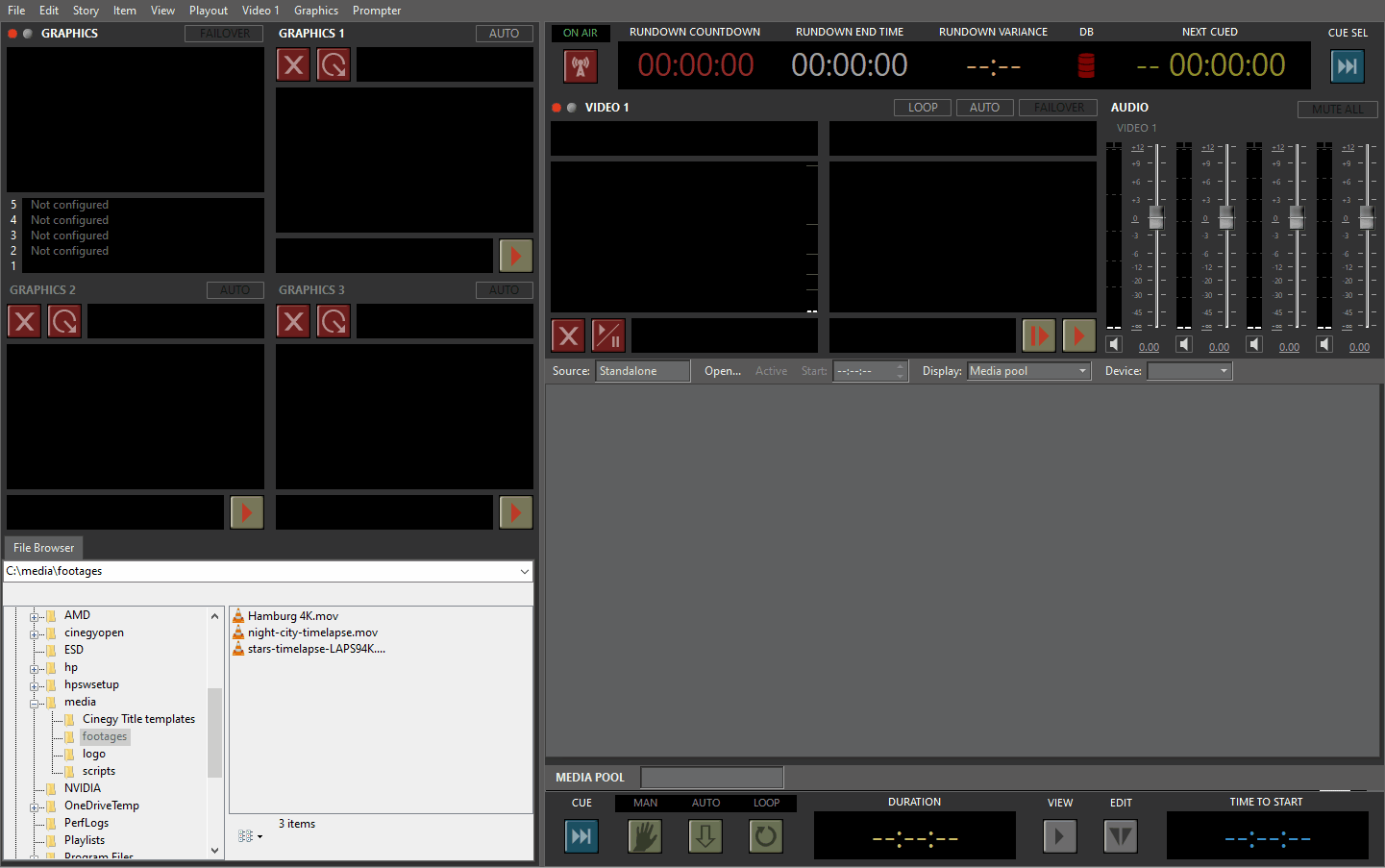
|
In the Rundown select the item which you want to send on air and press the "CUE SEL" button (or "CUE" button on the Item Editor panel). This item will be loaded to the "Preview" monitor. |
The video device panel consists of two parts. The right part of the panel contains the "Preview" monitor, which displays the first frame of the cued video item. The left part contains the "On-Air" monitor, which displays the first frame of the loaded item, and when the item is sent on air, its playback is displayed.
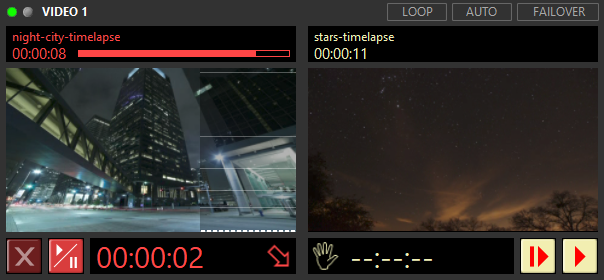
|
Press the "Start Cued" button to send the item on air. It will be displayed on the "On-Air" monitor. The next item of this type will be automatically cued; its first frame will be displayed on the "Preview" monitor. |
|
To load the first frame of the cued item to the device output, press the "Load Cued" button. It will be displayed on the "On-Air" monitor. The next item will be automatically cued. |
|
The "Play/Pause" button starts broadcasting of the loaded item. It is played on the "On-Air" monitor. Pressing this button for the second time pauses the playout. |
|
The "Stop" button interrupts the current loaded, paused or finished item and resets the device to the initial state. |
The graphics device panel operates in the similar way.
|
Important
|
For detailed information about working with graphics in Cinegy Studio, refer to the Sending Stories on Air article. |
Working with Prompter
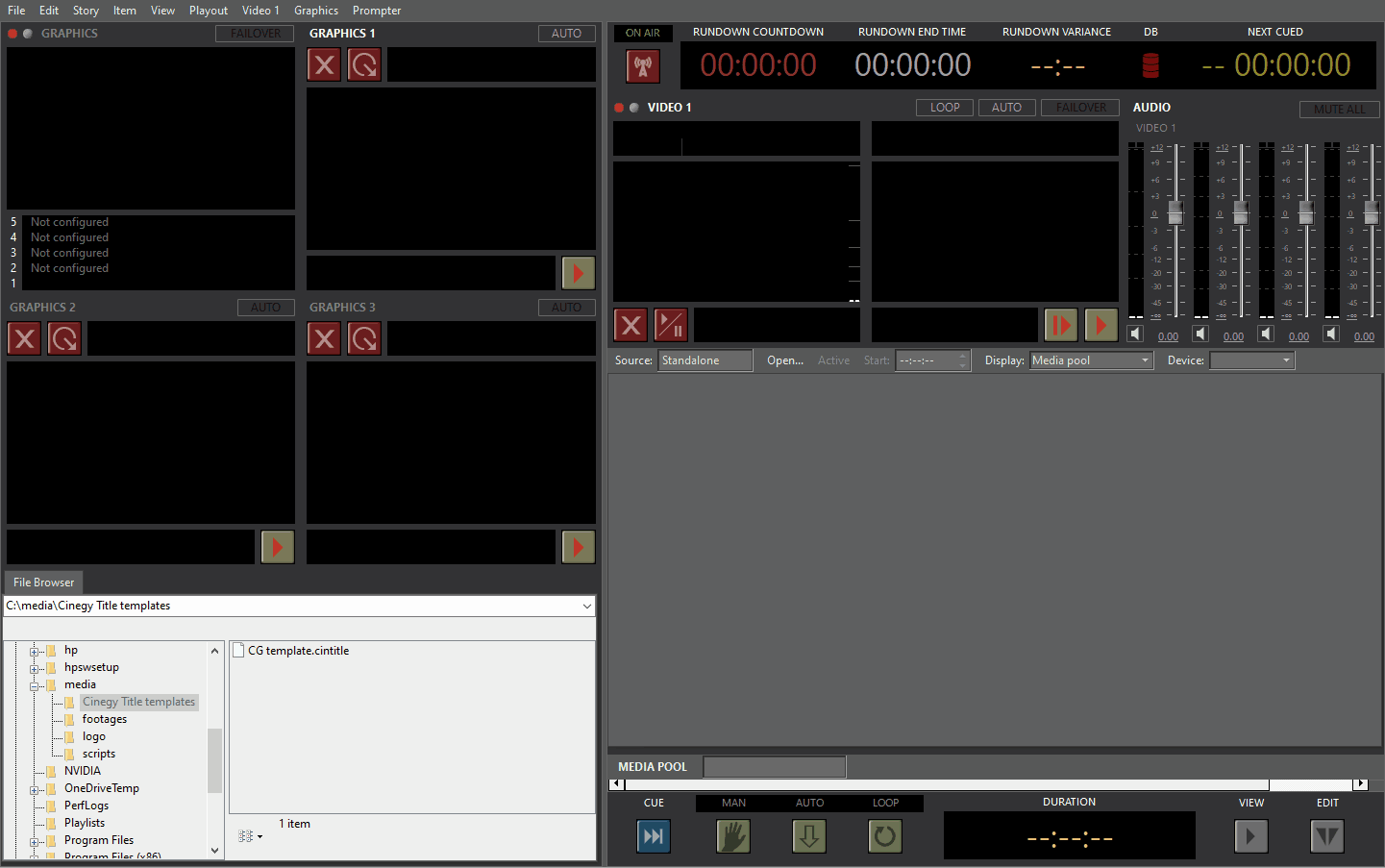
Before sending a script to the prompter device make sure Cinegy Prompter application is started. Then follow the steps:
-
Switch default layout to "Prompter" via the "View" main menu.
-
To connect all configured devices to the Cinegy Playout engine, use the "Connect All" command from the "Playout" main menu.
-
To create a new Rundown, press the "Open" button on the Rundown panel main toolbar. In the window that appears select the desired location and enter the playlist name. Or you can use the Rundown created while working through the previous section. For this navigate to the saved Rundown via "Open" dialog.
-
By using File Browser plug-in or File Explorer, add the text file containing the script to the Rundown.
-
Select the script item in the Rundown and press the "CUE" button on the Item Editor panel. The text will be loaded in the Prompter device.
-
Press the "Play" button to send the text to the Cinegy Prompter.
|
Important
|
For detailed information about configuring and operating Cinegy Prompter, refer to the Cinegy Prompter Manual. |






